Animal first aid
We are not veterinarians
However, we can give advice (by phone), provide first aid and arrange safe transport to a vet, for example. Below is a list of common conditions or situations we deal with.
Is your animal sick or in distress? Call your vet and us if you need transport (and first aid). We may be completely on the other side of town and own transport may be much quicker. In an emergency, always try to stay calm and think of your own safety. An animal in pain is unpredictable, and may lash out. Also towards the owner. Besides, animals take over your stress.
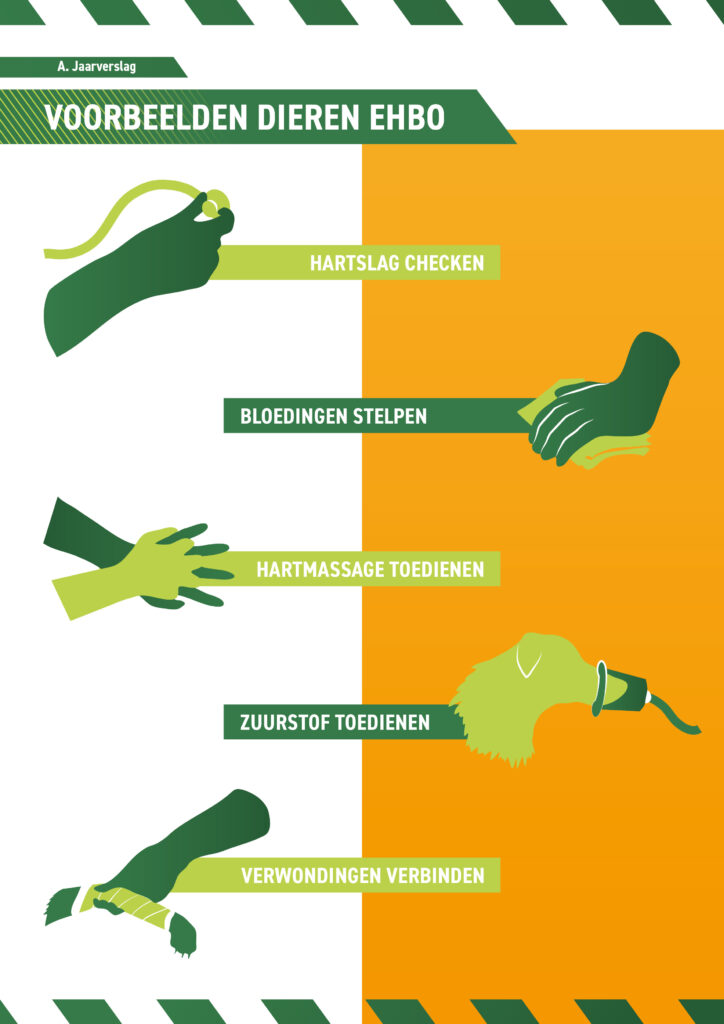
Bleeding
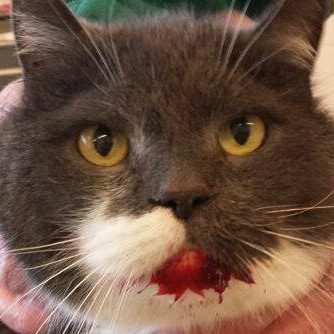
Bleeding comes in different types. In case of heavy bleeding, call your vet and us for first aid and transport. Look at the following tips to stop bleeding in the meantime. Our dispatchers can guide you by phone.
Tourniquet:
(only for heavy bleeding)
- If there is heavy bleeding on the leg, apply a "tourniquet" with a strip of cloth or a shoelace about 5 cm above the wound;
- Make a knot in the fabric;
- Place a pin or a sturdy stick on top and tie it tightly;
- Turn the pin or stick around until the strip of fabric is tight around the leg;
- When you drive to the vet, tie the strip on the stick so it cannot twist loose;
- Note: unscrew the fabric every 5 minutes to keep the blood flowing. This is very important to avoid tissue dying;
- Once you have applied the tourniquet, you can apply a pressure dressing to the injury if necessary. Then loosen the tourniquet to see if this is sufficient to stop the bleeding.
Arterial bleeding:
- Flows steadily from the wound; a wave of blood comes out with every heartbeat;
- The colour is bright red (lots of oxygen).
Venous haemorrhage:
- Blood is constantly flowing out of the wound, so a lot of blood can be lost;
- The colour is dark red (less oxygen).
What can you do?
- For heavy bleeding on the head or torso, take a clean cloth and press it firmly on the wound;
- In case of venous haemorrhage, press the blood vessels closed in the groin or armpit (from e.g. the injured leg);
- Place a tourniquet if necessary;
- If possible, cover the wound with gauze, a wad of cotton wool on top and secure with bandages;
- Bleeding on ear: often looks severe because of head shaking. Lay the ear flat on its head, cover the wound with gauze and wrap bandages or a tea towel around the head.
Botulism
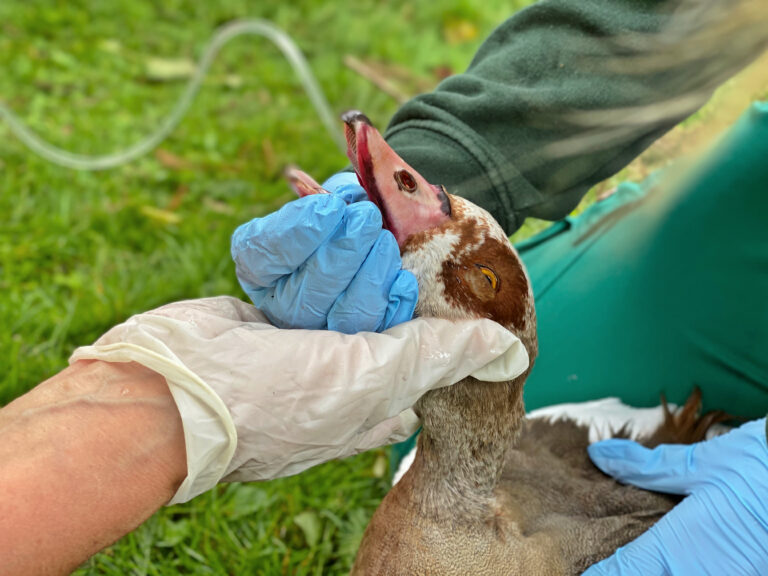
Possible symptoms, including:
- Paralysis symptoms;
- No longer able to fly or walk;
- Often make no sound anymore.
What can you do?
Calling us. By collecting sick birds, we not only increase the chances of survival, but also ensure that the water does not become (further) polluted, thus minimising further contamination. As soon as we find a botulism patient, we flush it on the spot and repeat this every half hour until arrival at the bird shelter. If we are on time, the bird's chance of survival is high.
Fracture
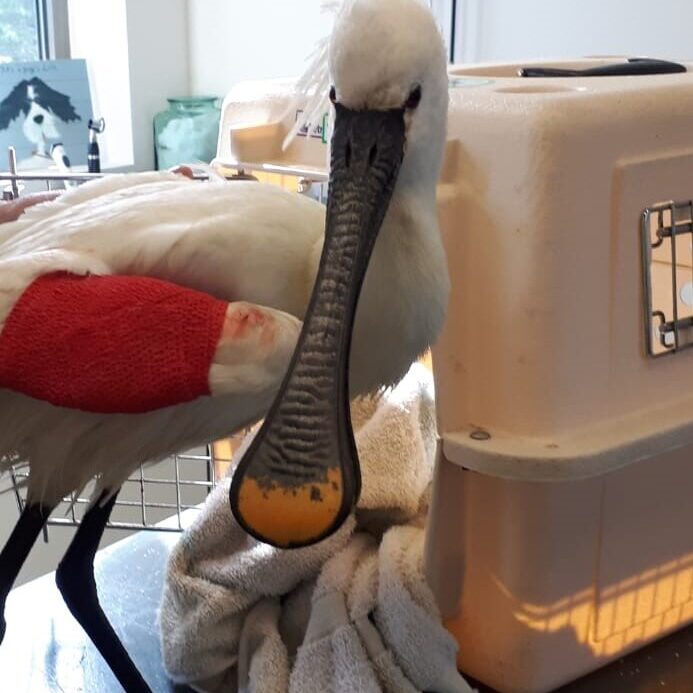
Bone fractures are often caused by brute force, such as a collision, fall or bite incident. Certain diseases can also cause fractures, such as bone tumours or osteoporosis.
In case of a broken leg: The animal is usually unable to stand on the leg and the leg often has a strange, unnatural position or abnormal mobility.
In case of a broken jaw: an abnormal position of the jaw, inability to chew, difficulty in swallowing and the mouth often no longer closes properly.
Think about your own safety. After all, your animal is in pain and even the most adorable pet can unintentionally bite as a result. Get your animal to a vet as soon as possible. If you call us, we will provide first aid and transport your animal as stably as possible.
Possible symptoms, including:
- Swelling;
- Pain;
- Shock;
- Sometimes you can see the bone parts sticking out of the wound (open fracture).
What can you do?
- Let the animal adopt a position he or she finds most comfortable on his or her own. Do not force anything;
- If the fracture is open (you can see a wound above the fracture, which does not necessarily show the bone), gently cover the wound with sterile gauze or a clean cloth. Prevent the animal from biting or scratching at it;
- If necessary, gently slide a rolled-up towel under the paw. This will ensure that the broken paw is stabilised.
Gastric torsion

Gastric torsion, also stomach twisting or called stomach tilt, is a very dangerous condition in (mainly large) dogs that is very painful and fatal if not dealt with quickly is intervened. At a gastric torsion the stomach rotates on its axis. This closes the entrance and exit of the stomach (in the case of oesophagus and colon). Blood vessels are also pinched off. As a result, blood pressure and heart function are lowered and the body does not get enough oxygen. Because the stomach is closed, gases produced by fermentation cannot escape and the stomach becomes increasingly bulgy. This expansion prevents the diaphragm from moving properly, restricting breathing. As a result, even less oxygen reaches the tissues. The stomach wall begins to die, bacteria in the intestines start secreting toxins, the kidneys and liver are affected and eventually the animal dies. Quick action is therefore necessary.
Preventive: let your dog eat calmly and give him or her at least half an hour's rest after eating.
Possible symptoms, including:
- Often trying to vomit in succession, without anything coming out;
- Drooling;
- Restless;
- Bloated belly;
- Stuffy.
- Go to the vet immediately;
- If possible, let your dog walk himself to the car or ambulance. Be careful when lifting. Do not exert pressure on the abdomen;
- The dog may stand, lie down or sit during transport; do not force the animal into any position other than it wants;
- The development of gastric torsion can never be completely prevented. However, you can reduce the chances by letting the dog eat calmly with not too large amounts.
Myxomatosis

Possible symptoms, including:
- Moist swellings around eyes, mouth and anus (appears 'snotty');
- 'Sleepy' eyes;
- Bumps around the mouth, ears and back.
What can you do?
See a suspected Myx rabbit? Place a box over it if possible. Call us and we will come and collect the animal as soon as possible. We take Myx rabbits to a vet for euthanasia. We transport the rabbit in a special 'myx box' to reduce the risk of infecting other rabbits.
Peeing male

A 'urinary hangover' is a male cat that suddenly cannot urinate. A blocked urethra is most common in male cats, as the urethra is narrower. If a female cat urinates little or not at all, it could be due to e.g. a bladder infection or bladder stones. Often male cats have had a bladder infection before, or suffer from bladder stones. If the urethra is clogged with grit, the animal cannot get rid of its urine. The urine contains toxins that need to be removed from the body. The bladder becomes increasingly full and at some point the kidneys can no longer discharge the urine, causing acute kidney poisoning.
Possible symptoms, including:
- To the bin regularly, with nothing coming out;
- Lying down in the bin;
- Small droplets of pee or nothing;
- Plaintive mewing;
- Braken.
What can you do?
The animal should go to the vet immediately. If not acted quickly, the animal may die within 24 hours.
Shock

Shock is a shortage of absolute or relative circulating blood volume. Blood pressure in the body drops as a result of, for example, blood loss, heart problems, fluid loss from burns, vomiting, diarrhoea, allergic reactions, electric shock or brain injury.
Blood flow is severely disrupted due to stress, shock, accident, external/internal bleeding. If shock is not treated properly, the animal may die.
Oxygen administration can be life-saving and prevent severe oxygen deprivation from leading to cell and organ damage. We therefore always give oxygen on the ambulance on the way to the vet.
Call your vet anyway.
It is important that you as the owner remain as calm as possible. Pay attention to your own safety and reassure the animal. Offer a low-stimulation environment and see more tips opposite.
Possible symptoms, including:
- Mucous membranes: pale/white (e.g. gums);
- Pulse: weak, rapid and sometimes irregular;
- Breathing: rapid and shallow;
- Consciousness: drowsy, unconscious or coma, or enlarged flight response;
- Limbs cold, torso warm;
- Eyes: lie deeper in the sockets;
- Pupils: wide;
- Temperature: decreases slowly. Can go up to 27 °C (normal temperature 38-39 °C).
What can you do?
- If possible, try to eliminate the cause of the shock;
- Prevent further cooling by placing a blanket over the animal (do not make it too warm);
- Stop and bandage bleeding if possible;
- Never give drink or food.
Bird flu
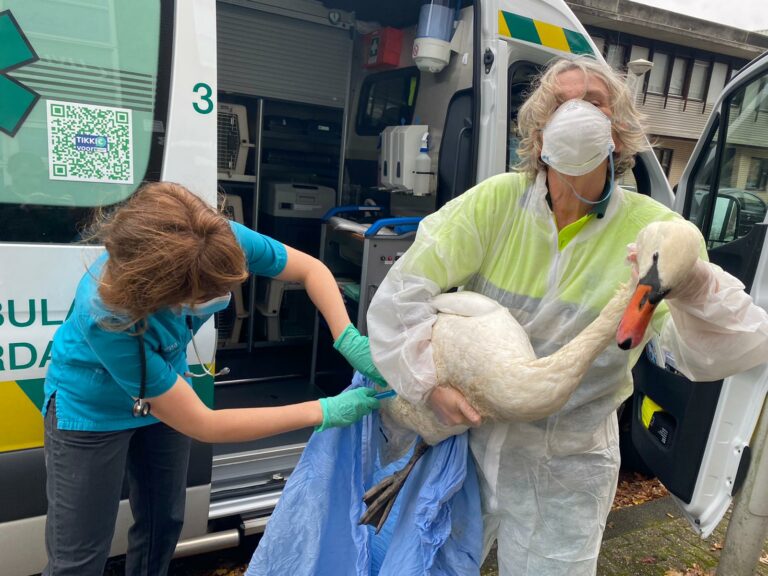
Possible symptoms, including:
- Spinning around; (with neck or walking/ swimming)
- Sluggishness;
- Respiratory problems;
- Unable to fly anymore;
- Fall over.
What can you do?
It is also noticeable if there are several deceased birds lying together. If you see a bird with one or more symptoms or several deceased birds together: do not touch them, but call us. Besides wild birds, mammals such as the fox or otter can also become infected. So also make sure your dog does not get close to possible bird flu victims.
Has your pet not yet been microchipped:
we chip and register
Yes, I give
... To the animals of Amsterdam
